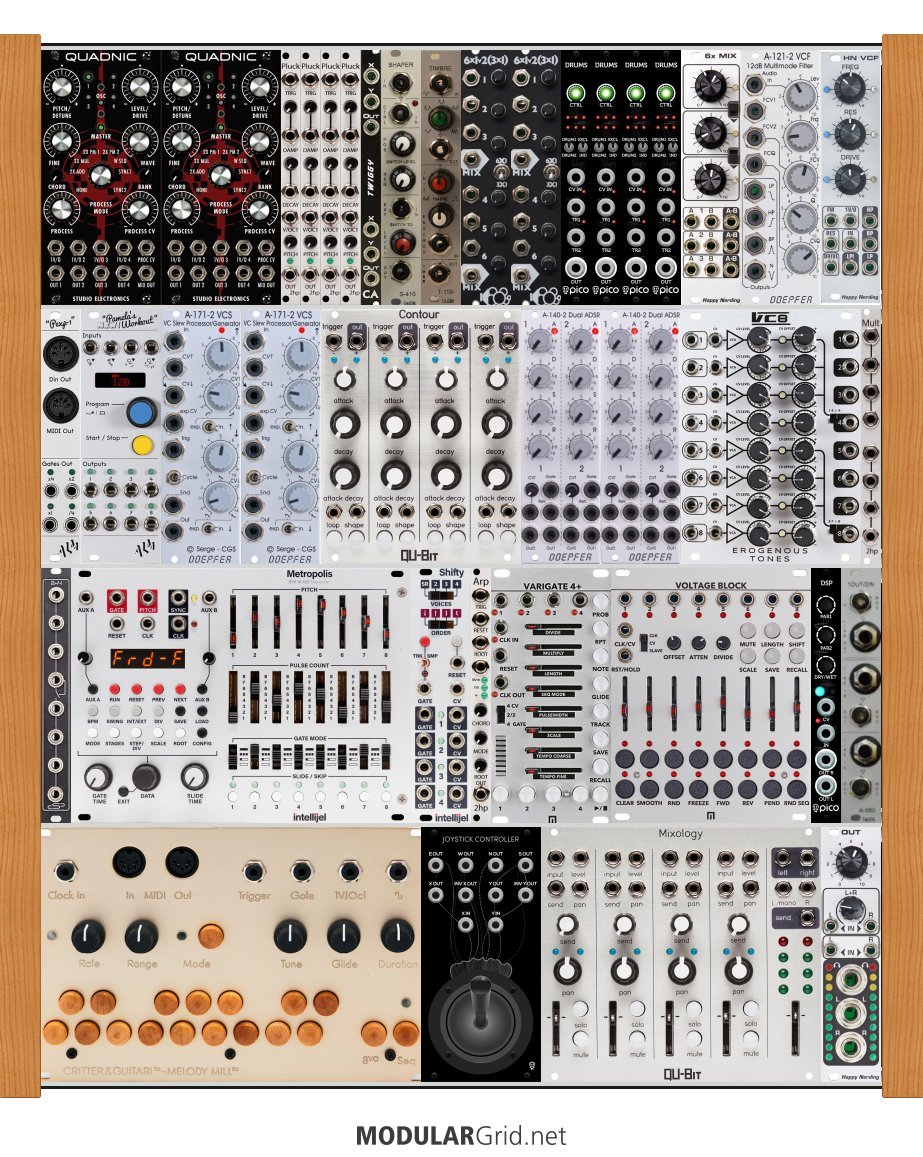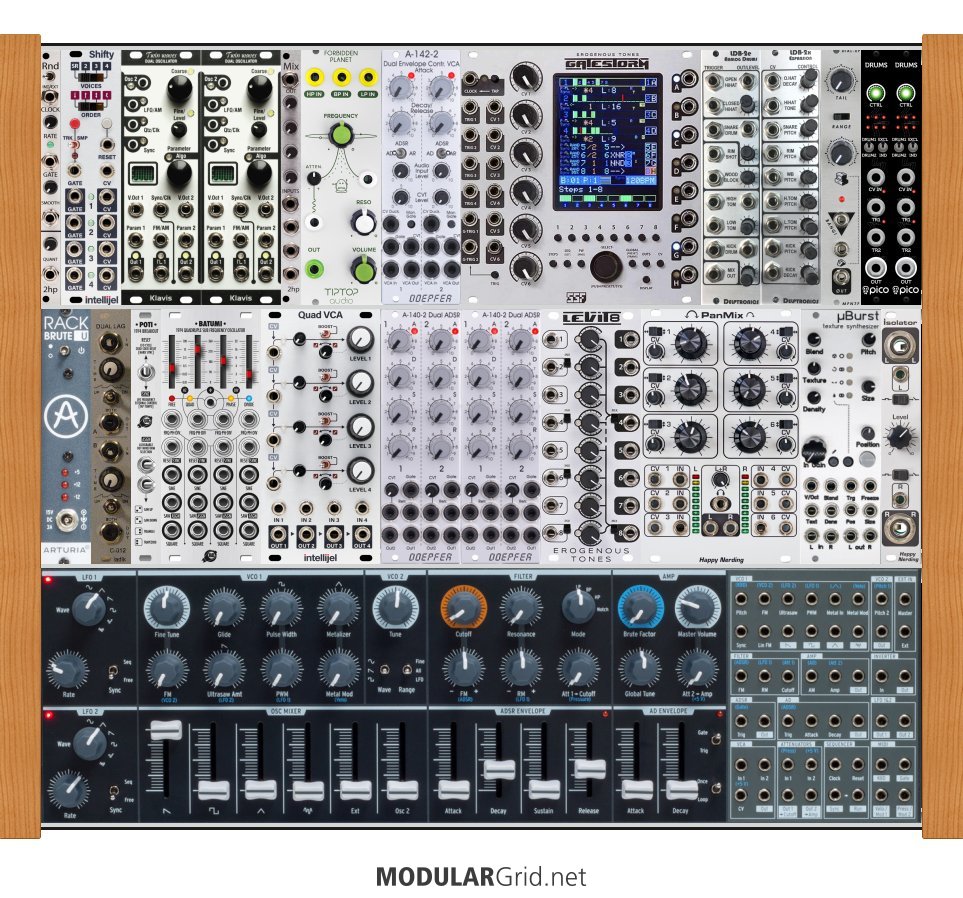Well, it's about that time again, so here's KICK ASS!!! for November 2018, in which (as usual) I point out some of the more interesting-looking and sounding Eurorack modules for the MG audience.
Things seem to be picking up...I've run across a nice number of bits 'n' pieces to look over, so without further ado:
1) LeafAudio Noisefoc. This thing is way-raucous! It uses TTL-type logic circuits to generate sound, and the result sits right in the cusp between 'noise generator' and 'VCO', I think. The audio clip at LeafAudio's website (link in the module entry) really shows off the sort of aural pandemonium this module's capable of. It's worth noting that the EDP Wasp used similar TTL logic to generate sounds, but where EDP kept things under control (more or less), Leaf allows all of the utterly crazed possibilities to shine through here. And don't just look at it as 'noise'...used carefully, the Noisefoc's capable of adding some complex timbral content alongside basic ol' VCOs, so most anyone could find a use for this. This module's a kit...but you might want to brush up on your soldering skills and give this a shot. 8 hp, around $28, probably via Exploding Shed although the listing for it isn't up on there yet.
2) Takaab Nearness. Takaab's been putting out some interesting but simple twists for a good price for some months now, and this is no exception. This is a fixed level mixer with seven inputs and a stereo pair of outputs...but the twist is that by using the patchpoints closer to each stereo out, the signal to that particular output gets louder. Simple, yep...but imagine this in tandem with a couple of panners. Well, that would give you lots of stereo spatial modulation just by feeding a basic LFO into the panners without a whole bunch of fuss or expense. You can even configure it via a jumper for line-level output, which is awfully convenient and saves on a separate output module. 3 hp, and about $50.
3) ALM Busy Circuits Quaid Megaslope and MCO. Two nifty toys from ALM...the Quaid Megaslope can work as a multisegment EG (sort of in the style of the Casio CZ envelopes), a very adjustable complex LFO, or even as a sequencer with sequenced slope functions. This thing has 'useful' written all over it; I'm sure there's things that can be done with one that go way beyond what I'm capable of explaining. 19 hp, $308, more or less. Then the MCO...oh, boy, is this thing crazy! It's a wavetable VCO in a very convenient 6 hp, but it also has some complex CV functions hidden inside. The PWM and 'Type' controls govern a bunch of interesting pulsewidth weirdnesses, and the 'Wave' control lets you morph through the stored wavetables smoothly. ALM says that this VCO will sound very much like 1990s digital, and having heard it on their website (link in the listing), I'd have to say that's spot on. What I heard sort of reminded me of a cross between the Kawai K3 and K4 oscillators...very 'cold' coloration that hovers in a zone between analog and lower-fi PCM. $174 at the present $ exchange rate.
4) Pharmasonic Digisound modules. I own (for about 20 years now) and love a 22-module Digisound system. These were kit devices dating from the 1980s, and even while using Curtis chips for the most part for their main operation, they were flexible enough so that you could easily patch your way into totally weird areas...industrial grind, ethereal drones, and loads of other things in between. And one of the real secrets to what made the Digisound line cool is their take on a wavetable VCO, the sought-after VCDO. Well, seek no more! Pharmasound's brought the Digisound VCDO back, along with ten more of its siblings, staying true to the original architecture and using the new versions of the Curtis chips. But the VCDO is the real prize here...32 waveforms that can be stepped through in both the tables and table banks, making it a great candidate for sequencer-heavy systems to juice up timbral variation in time with the sequenced pitches. I do hope there's more in the pipeline from Pharmasonic on this front; it would be very cool to compliment my old-skool Digisound with some identical new Eurorack friends. All modules (thus far) are 12 hp, and the VCDO in particular comes in at a very affordable $209.
5) Ladik P-180 Octal switchable 'OR'. Ladik's still popping out some intriguing and inexpensive Eurorack toys. This month, they kicked out their first 'real' VCF, but I picked this thing because, if you're running a system that uses lots of trigger/gates (say, with a few sequencers) and clocking, this thing is a godsend! You have eight logical ORs on this, and you can use each OR's switching to select either the A or B, or a combination of the two via the logical OR. That last part, in particular, makes this appealing for live sequencer work to play havoc with your timing signals with ease. 12 hp, and the kicker is the price: $64, more or less! Most any other device that gives you timing control on this order is going to cost waaaaaymore!
6) 1010 Music Laserbox. OK, on the surface, it's just a laser controller for driving an ILDA laser projector. And that's extremely cool in of itself, especially since you can have a real-time view of the RGB traces on the module via its touchscreen. But hold up...this outputs + and -5V, meaning you could just as well use it, well, anywhere! Now, consider the fun of applying these Lissajous patterns that you can view and control on the module to audio modules. That could give you some really tasty complex modulation which you can use most anywhere. I can figure the generative music crowd would find a million uses for something of this sort. ADDAC had, until recently, a Lissajous generator/LFO in their lineup, but this new take on that idea from 1010 seems to be a lot easier to understand and use in real-time. 26 hp, $599.
7) Percussa mSSP. Also in at 26 hp, this shrunk-down variation of Percussa's powerful SSP might be smaller, but it's hardly less powerful. Loads of different synthesis methods are hiding behind its panel, way too many to go into here. But the real difference here is the price: $549, as opposed to the $2k for the full-on SSP. This thing makes me drool, really...not only does it have the similarities in raw synthesis power like its bigger sibling, but the 'footprint' fits much better into the Eurorack-verse and that price tag is...well, wow! Yeah, I can hear a few people saying that it doesn't have this or that, the screen's smaller, etc. But it loads any patch made on the original, and doesn't eat 60 hp while doing that and more. It's currently in Kickstarter for $549 for the retail version, and has only a few weeks to go while still needing about another $100k, so bust out that magic plastic quick! Hopefully just as the SSP made its Kickstarter goal, we'll see this get over the line as well.
8) Klangbau Köln Frequency Shifter. Add your own quadrature oscillator, and you're shiftin' like a boss. This is basically the 'guts' of a Bode frequency shifter, minus an internal oscillator source for the shifting. But it's got a few tweaks, such as a control (the 'RMO' knob) that lets you morph between ring modulation and proper single-sideband suppression, or a bit of extra I/O for doing delayed shifts. And with the shift frequency set up the way it is, there's lots of abuse potential for feeding those with things that aren't quadrature sine waves. This module has a good little bit of crazy hiding behind its panel, more or less...but the real craziness is the price: $246 plus/minus. Priced a proper frequency shifter lately? If you haven't, bring some tissues for the ensuing nosebleed! KK's taken care of that, though, with the real deal for way less than the usual cost. 10 hp.
9) Steffcorp VCF-12. Take an ARP 4012 VCF. Now, add a lot of freaky stuff...dual KBD CV ins, an extra 2-pole output, a variable-slope (CVable!) out, dual (one invertable) FM CV ins, and you've now got some weird mutant VCF on your hands! It might've originally come from an ARP 2600, but it's gotten mutated into some sort of strange, very CVable creature. Steffcorp even hand-selects the critical parts necessary to give the proper 2600 filter sound, but that's not going to be all you can do with this thing. Potent! 14 hp, $306.
10) North Coast Synthesis MSK 009 Coiler VCF. Speaking of weird, here's a really different take on filtering altogether. The Coiler gets its name from what it uses: inductors. This is an inductor-based multimode VCF, which means it'll have lots of odd nonlinearities, curious behavior, and the like. But as if that wasn't enough, North Coast added a second audio input that feeds your signal through a full-wave rectifier, giving you some extra waveshaping and distortion possibilities that are, well, weird. But very welcome, too. You can get it in two flavors: the assembled version, which is about $204, and a through-hole kit for $136-ish. Oh...and it can also do a few envelope-following tricks, too! Like I said...weird! 8 hp.
11) 2hp Play. Take a sample playback module and leave it in the dryer too long. This is what you get: the absolutely-smallest Eurorack sample player out there. I'm often amazed at the functionality-cramming that 2 hp gets away with, but this is a shocker. Capable of loading 32 mono samples at a time with sample switching via its CVable file control knob, you also get CV control of pitch (1V/8va tracking, of course), several playback modes, software updating and tweaking via micro SD, and it comes with a preloaded micro SD to get you started, all for a measly $149. Talk about a functional gap-filler!
And that, as they say, is that! Nice to see such an interesting bunch of newcomers. Some of these would make for awesome stocking stuffers, too...provided the stocking in question has the proper current supply! Until next month...and for that matter, next year!


